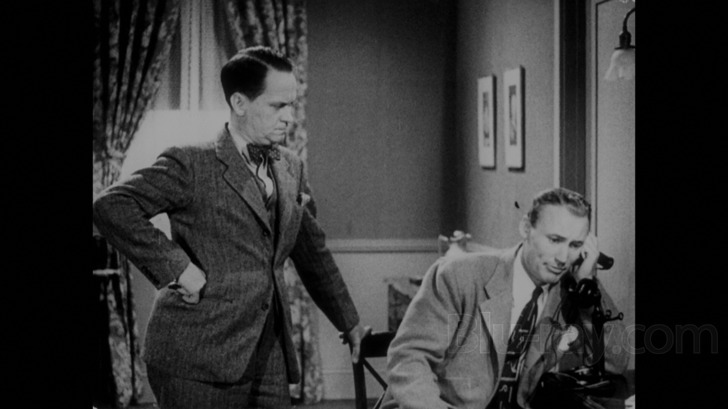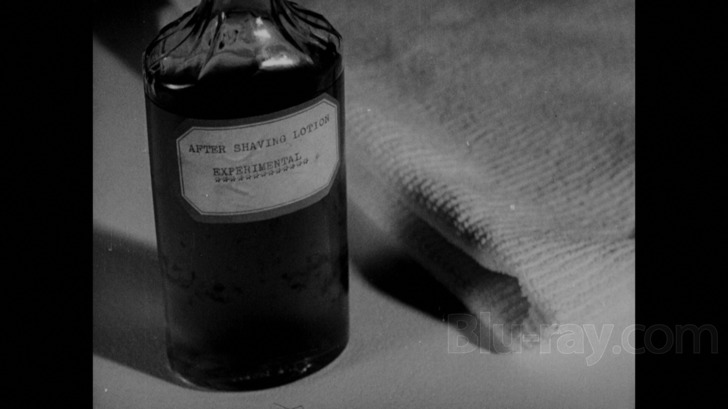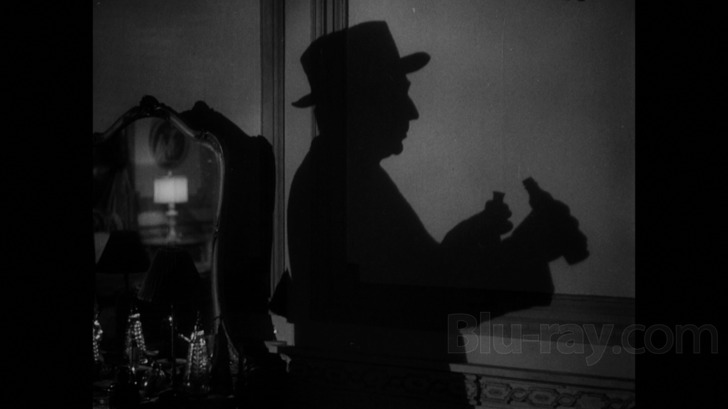The Devil Bat Blu-ray Movie
HomeThe Devil Bat Blu-ray Movie 
Kino Lorber | 1940 | 70 min | Not rated | Sep 17, 2013Movie rating
5.7 | / 10 |
Blu-ray rating
| Users | 0.5 | |
| Reviewer | 2.5 | |
| Overall | 2.5 |
Overview
The Devil Bat (1940)
Dr. Carruthers feels bitter at being betrayed by his employers, Heath and Morton, when they became rich as a result of a product he devised. He gains revenge by electrically enlarging bats and sending them out to kill his employers' family members by instilling in the bats a hatred for a particular perfume he has discovered, which he gets his victims to apply before going outdoors. Johnny Layton, a reporter, finally figures out Carruthers is the killer and, after putting the perfume on himself, douses it on Carruthers in the hopes it will get him to give himself away. One of the two is attacked as the giant bat makes one of its screaming, swooping power dives...
Starring: Bela Lugosi, Suzanne Kaaren, Dave O'Brien (I), Guy Usher, Yolande DonlanDirector: Jean Yarbrough
| Horror | Uncertain |
| Sci-Fi | Uncertain |
Specifications
Video
Video codec: MPEG-4 AVC
Video resolution: 1080p
Aspect ratio: 1.32:1
Original aspect ratio: 1.37:1
Audio
English: LPCM Mono
Subtitles
None
Discs
25GB Blu-ray Disc
Single disc (1 BD)
Playback
Region A (B, C untested)
Review
Rating summary
| Movie | 2.5 | |
| Video | 3.5 | |
| Audio | 3.5 | |
| Extras | 2.0 | |
| Overall | 2.5 |
The Devil Bat Blu-ray Movie Review
I smell a rat...with wings.
Reviewed by Casey Broadwater September 16, 2013Poor, undervalued Bela Lugosi. His career is one of Hollywood's great tragedies. After a name-making turn in 1931's Dracula—in which he played the count with a cruel, hypnotizing seductiveness—Lugosi found himself increasingly typecast, second-billed to costars like Boris Karloff, and unable to convince producers that he was fit for non-horror roles. By the late 1930s, when he became stricken with chronic sciatica that left him addicted to methadone, he was largely confined to low-budget Poverty Row features, eking out a living taking increasingly demeaning and routine parts as mad scientists and monsters, Svengalis and psychopaths. One of the most middling of these is 1941's The Devil Bat, a hokey horror-comedy from Producers Releasing Corporation, a low-rent studio even by Poverty Row standards. Clocking it at a slim 68 minutes, the film screams "cheap" and feels like it was created specifically as the B-side filler for a bad double feature. Were it not for Lugosi's magnetic presence, it's doubtful The Devil Bat would still be watched today, and even with Lugosi the movie drags, padded with repetitive plot elements. That's not to say there isn't any delicious B-movie cheese here—there certainly is—but the film doesn't quite have enough of it to make for a so-bad-it's-good scenario.

Lugosi—surprise, surprise—plays yet another mad scientist, the "kindly village doctor" Paul Carruthers, whom no one suspects of performing "weird, terrifying experiments" in his secret basement laboratory, which is located behind a sequence of hidden switches and false doors. A formula patent scientist for Martin Heath Cosmetics by day, Carruthers spends his nights experimenting on a pet bat, suspending it beneath a device that wouldn't look out of place in Nikola Tesla's workshop and zapping it with bolts of electricity, causing it to quadruple in size. ("Ah, my friend," he says to the now super- sized bat in a luny bit of dialogue, "our theory of glandular stimulation through electric impulses was correct.") What's more, Carruthers has trained this jumbo bat to act aggressively when it catches the scent of the doctor's latest formulation for Heath Cosmetics, a strong-smelling shaving lotion.
What, you might rightfully ask, is a creator of toiletries doing training an enormous bat to attack? The film wastes no time supplying an answer. For years, Mr. Heath (Edmund Mortimer) and his business partner Henry Morton (Guy Usher) have been getting fat-cat rich off of Carruthers' patents, while the doctor himself lives in relative modesty, trapped in a lousy contract. They try to placate him by having Mr. Heath's son Roy (John Ellis) hand-deliver a $5,000 bonus check, but the pitiful amount only angers Carruthers further. He takes the opportunity to put his killer bat to the test, asking Roy to try some of the new experimental aftershave. When Roy leaves, reeking of the stuff, Carruthers looses the bat, which zips stiffly out a window—clearly attached to a wire—and swoops down to kill the young man in the presence of his sister Mary (Suzanne Kaaren) and her would-be paramour, Donald Morton (Gene O'Donnell).
And thus the Devil Bat's reign of slow, uninteresting terror begins. Carruthers intends to have his revenge by wiping out Heath, Morton, and their (adult) children, so he sics his mutant winged throat-biter on them one at a time, somehow convincing each to try his odd-smelling aftershave first. (The secret ingredient, we learn, is a "molecule" used in Tibetan rituals. Oooooooh.) Meanwhile, fedora-wearing reporter Johnny Layden (Dave O'Brien) and his comic-relief photographer sidekick—"One-Shot" McGuire (Donald Kerr)—swoop in from the big city, sniffing after the story with permission from Police Chief Wilkins (Hal Price) to aid in the investigation. To give some sense of just how dull the movie is, the two journalists spend much of the movie either 1.) on the telephone, or 2.) in the Heath estate's garden, simply waiting for the bat to show up. The most excitement we get is when "One-Shot" convinces the Heath's French maid to show a little more stocking as she poses for a cheesecake portrait. That, or when "One-Shot" shows his lack of journalistic integrity by faking a photo of the now-famous Devil Bat, nearly getting himself shot in the process.
It's dopey, by-the-numbers stuff, and it lacks the mystery and atmosphere of the best horror films from the '30s and '40s. Everything about The Devil Bat is mediocre. The B-list actors hamming up their over-obvious dialogue. The way the same footage of the bat emerging from Carruthers' window is recycled multiple times. The cornball rubber-bat-on-a-string "special" effects and the creature's obnoxious shriek, which sounds conspicuously like a monkey's. Some of this lends itself to moments of unintentional hilarity and an appreciation for low-budget horror goofiness, but in this regard, The Devil Bat pales in comparison to some of the true turkeys Lugosi would later make with the prolific and prolifically awful Ed Wood. For his part, Lugosi isn't bad here—he veers from charming to avuncular to two-faced to menacing—and he's a pleasure to watch simply because he elevates what would've otherwise been a dippy, entirely forgettable role. Still, you can't shake the sense that this is one of those parts he took for the weekly paycheck.
The Devil Bat Blu-ray Movie, Video Quality 

As a film in the public domain, The Devil Bat has long been subjected to home video releases of less-than-stellar quality, but Kino-Lorber aims to give us a presentation that—while not perfect—aims to be more definitive. The 1080p/AVC-encoded transfer here, like a lot of Kino releases, is essentially offered up as-is, with no significant digital cleanup or restoration beyond some contrast balancing. (And the blacks and whites are fairly stable, barring some occasional brightness fluctuations.) The print is littered with age-related artifacts—white specks, scratches, brief jitters—and while these could feasibly be removed with enough time, money, and effort, their presence certainly isn't detrimental to the viewing of the movie. Simply scanning the film in high definition, making the tonality consistent, and foregoing any unnecessary filtering—DNR, edge enhancement—is enough to make this edition stand out above all previous versions. While the image is never particularly sharp, there's a clear improvement from standard definition editions, with finer detail visible in the actors' faces, clothing, and the film grain itself.
The Devil Bat Blu-ray Movie, Audio Quality 

Kino-Lorber has given the film an uncompressed Linear PCM 2.0 mono track that's as good as can be expected, considering this is a seventy-two year old Poverty Row production that's been badly mistreated through the years. Yes, there are some of the usual age-related quirks—some light hissing, occasional pops and crackles, some brashness in the high end—but nothing that mars the experience. Dialogue is always easily understood, which is good since there are no subtitle options, and the spooky score—with its sudden violin stabs—is projected well. No issues here outside the normal early-talkies wear 'n' tear.
The Devil Bat Blu-ray Movie, Special Features and Extras 

- Audio Commentary: Horror movie historian Richard Harland Smith expresses his affection for the film and gives us a thorough breakdown of The Devil Bat's production and cast. It's mostly dry stuff—like the film itself—but for those interested in low-budget horror history, it's worth a listen.
The Devil Bat Blu-ray Movie, Overall Score and Recommendation 

Despite a ludicrously fun-sounding premise—a mad scientist creates a killer bat that tracks its victims by the scent of their aftershave—The Devil Bat is one of Bela Lugosi's less memorable Poverty Row outings. It's a rather routine low-budget early 1940s horror movie, and even Lugosi's smiling-but-dark-hearted presence can't keep the film from feeling dull. And while it has its moments of retrospectively enjoyable badness—like the truly awful special effects—there are too few of them to push The Devil Bat into the "so-bad-it's-good" category. This one's strictly for diehard Bela Lugosi fans, but if you fall into that camp, you'll be pleased with Kino-Lorber's new Blu-ray release, which features a decent new high definition transfer, uncompressed audio, and a dry-but-insightful commentary from horror historian Richard Harland Smith.
Similar titles
Similar titles you might also like

The Black Sleep
1956

The Invisible Man 4K
1933

Doctor X
Warner Archive Collection
1932

Them!
1954

Jungle Captive
1945

Carnosaur
1993

Laserblast
Collector's Edition
1978

The Manster
The Split
1959

The Brain That Wouldn't Die
1962

Bride of Re-Animator
1990

The Invisible Man Returns
1940

The Suckling
Sewage Baby
1990

Hatchet III
2013

Frankenstein Must Be Destroyed
1969

The Fly II
1989

Mega Piranha
2010

Frankenstein 4K
1931

The Bride of Frankenstein 4K
1935

The Evil of Frankenstein
Collector's Edition
1964

The Creature Walks Among Us
1956
